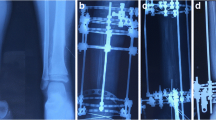Abstract
Objective
Wide resection of a tumor of the distal femur in healthy tissue while sparing the knee joint and preserving function of the limb.
Indications
Tumors of the distal femur on the conditions that the distal epiphysis can be preserved for stable anchorage of a condylar blade plate, that limb-sparing surgery is possible and that tumor therapy is curative (expected survival time at least 5 years).
Contraindications
Large defects which cannot be bridged by a sliding graft.
No possibility for stable anchorage with the condylar blade plate.
Generalized tumor disease.
Local infections.
Surgical Technique
Wide tumor resection through a posterolateral approach. Reconstruction of the defect with a proximal femoral sliding graft, free contralateral fibular transplant and autogenous iliac bone graft. Stabilization of the fragments with screws and a long condylar blade plate.
Results
A 20-year-old woman with an osteoblastic osteosarcoma and a 15-year-old boy with a low-grade chondrosarcoma were treated with this technique. In none of the patients a local recurrence or metastasis was observed 9 and 7 years, respectively, after tumor resection. Full weight bearing could be resumed at 6 weeks in the first and at 12 weeks in the second patient. At the latest follow-up, both patients had good to excellent functional results.
Similar content being viewed by others
References
Asada N, Tsuchiya H, Kitaoka K, Mori YT. Massive autoclaved allografts and autografts for limb salvage surgery. A 1–8 year follow-up of 23 patients. Acta Orthop Scand 1997;68:392–5.
Blauth W. Fortschritte in der Behandlung von Knochendefekten. Münch Med Wochenschr 1974;116:77–86.
Blauth W, Hippe P. Defektüberbrückung langer Röhrenknochen mit homologen Knochenröhren. Hefte Unfallheilkd 1987;179:190–204.
Böhm P. Die Replantation extrakorporal devitalisierter Knochenresektate zur Defektrekonstruktion in der Tumororthopädie — eine Übersicht. Z Orthop Ihre Grenzgeb 1998;136:197–204.
Cannon SR. Massive prosthesis for malignant bone tumours of the limbs. J Bone Joint Surg Br 1997;79:497–506.
Horowitz SM, Glasser DB, Lane JM, Healey JH. Prosthetic and extremity survivorship after limb salvage for sarcoma. How long do the reconstructions last? Clin Orthop 1993;293:280–6.
Mankin HJ, Springfield DS, Gebhardt MC, Tomford WW. Current status of allografting for bone tumors. Orthopedics 1992;15:1147–54.
Tsuchiya H, Tomita K, Minematsu K, Mori Y, Asada N, Kitano S. Limb salvage using distraction osteogenesis. J Bone Joint Surg Br 1997;79:403–11.
Author information
Authors and Affiliations
Corresponding author
Rights and permissions
About this article
Cite this article
Mau, H., Ewerbeck, V. Sliding bone graft at the distal femur after wide resection for malignant tumor. Orthop Traumatol 10, 159–168 (2002). https://doi.org/10.1007/s00065-002-1045-9
Issue Date:
DOI: https://doi.org/10.1007/s00065-002-1045-9




